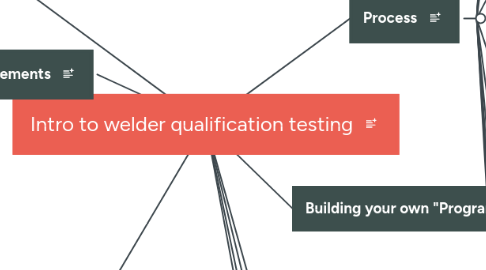
1. Scope and responsibilities
1.1. Companies need to know where they fall
2. Code Requirements
2.1. Know them!!!
2.2. Have the code
2.2.1. Before testing for review
2.2.2. During Testing For Reference
2.2.3. After Testing for record
2.3. Default for Most US Codes
2.3.1. MFG or Contractor tests own welders
2.3.2. WPS Required
2.3.3. Essential variables must be addressed
2.3.4. Some or all may be subcontracted
2.3.5. Company Maintains responsibility
2.3.6. Testing May be many methods
2.3.7. Some require welder vision test
2.3.8. Some require training (248)
2.3.9. May allow acceptance of other testing.
3. What is a good welder?
3.1. Code rules for tests may not be sufficient
3.2. Production conditions vs test
3.3. Is time a factor?
3.4. Should there be a "knowledge" factor.
3.5. Varies by project.
3.6. Test may "qualify" for many welds but does not verify ability.
4. Process
4.1. Know what the specific code requires
4.1.1. Never test anyone without having the code
4.1.2. have it available
4.1.3. Exceptions allowed/requested by customer-Document!
4.1.4. If additional restrictions allowed/requested. Document
4.1.5. Refresh your knowledge
4.2. Verify the requested qualifications and review with the customer
4.2.1. More to it than welder testing for production
4.2.2. Certified Welder Article
4.2.3. Show code paragraph regarding responsibility
4.3. Document review of requirements
4.3.1. Welder Test Plan/WPQTI
4.3.2. Document additions/exceptions and obtain sig
4.3.3. If an individual, who is "certifying the document"
4.4. Review reqts with welder
4.4.1. Safety
4.4.2. WPS Review
4.4.3. Acceptance Criteria
4.4.4. Equipment Operation
4.4.5. Hold Points
4.4.6. Position Secured
4.4.7. Test Assembly ID
4.4.8. Filler Metal locations
4.4.9. Using your "opinion"
4.4.10. Grinding
4.4.11. Others in booth
4.4.12. welding outside WPS ranges
4.5. Fitup and Tack
4.5.1. Tack Locations
4.5.2. May be any process if not in joint
4.5.3. Backing Strip Standoff
4.5.4. No Visible misalignment
4.5.5. If tacks in Joint, length location
4.5.6. Untitled
4.6. Mark test Assy
4.6.1. Unique # (database)
4.6.2. At destructive test locations preferred
4.6.3. TOP on pipes
4.6.4. no names/ss #
4.6.5. Steel Stamp not vibro or paint
4.7. Locate in position
4.7.1. What variation does code allow?
4.7.2. Allowed to move location but not position.
4.7.2.1. May be restricted for higher "level" tests.
4.7.3. No removal for grinding.
4.7.4. If noticed removed from position-Fail
4.8. weld root pass
4.8.1. STart and Stop Required?
4.8.2. Hold Point
4.8.3. Welder may correct anything BEFORE requesting inspection
4.8.4. Observation of skills may require "opinion"
4.9. inspect and document
4.9.1. WPQTI
4.9.2. Some codes have acceptance criteria some do not
4.9.3. OQE
4.10. fill and cap
4.10.1. Follows WPS
4.10.2. Listen/look for excessive grinding.
4.10.3. Observe position
4.11. inspect final layer
4.12. remove
4.13. verify documentation matches test#
4.14. Perform Testing
5. Building your own "Program"
5.1. Have a written system
5.2. AWS B5.4
5.2.1. Great Starting Point.
5.2.2. Calibration Req.
5.2.3. Qualifications of Inspectors
5.3. May add requirements
5.3.1. Time Limits
5.3.2. Tighter WPS requirements
5.3.3. Looser WPS variables
5.3.4. modify test location/restrictions
5.3.5. additional hold points.
5.3.6. additional tests
5.3.6.1. sides and face/root
5.3.6.2. Dest and NDE
5.3.6.3. bead width/height variation
5.4. Can be better than AWS ATF welders
5.5. Reviewed by Local Industry
5.5.1. Thier perception may be wrong but valuable
5.5.2. Find out what they require and build around. Company Specific "test plans"
5.5.2.1. Great for Students
5.5.2.2. Great for potential employee screening
5.6. OQE-2018
5.7. Personnell
5.7.1. Who must supervise?
5.7.2. Who has final certification authority.
5.7.3. What do they need to know.
5.7.4. Is a "certification" needed
